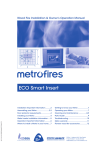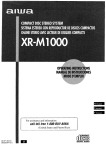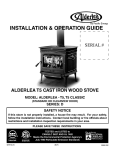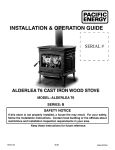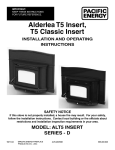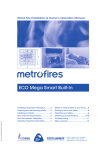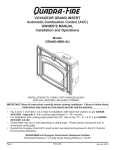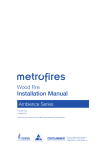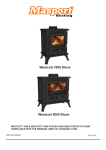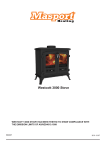Download Alderlea T4 CLASSIC Operating instructions
Transcript
IMPORTANT: KEEP THESE INSTRUCTIONS FOR FUTURE REFERENCE. Alderlea T4 AUSTRALIA INSTALLATION AND OPERATING INSTRUCTIONS - AUSTRALIA SERIAL # SAFETY NOTICE If this stove is not properly installed, a house fire may result. For your safety, follow the installation instructions. Contact local building or fire officials about restrictions and installation inspection requirements in your area. MODEL: ALDERLEA T4, T4 CLASSIC SERIES - C 010515-20ALT4 ©PACIFIC ENERGY FIREPLACE PRODUCTS LTD. - 2015 5055.302AS Contents Contents....................................................................................................2 Safety and Maintenance...........................................................................3 Maintenance Checks................................................................................ 4 Formation and Need for Removal..................................................................................................5 Chimney Fires.............................................................................................................................................5 Avoiding a Chimney Fire......................................................................................................................5 Creosote....................................................................................................5 Appliance Dimensions............................................................................. 6 Outside Air Opening Dimensions........................................................... 6 If You Suspect a Chimney Fire.........................................................................................................6 In Case of a Chimney Fire...................................................................................................................6 Installation ................................................................................................7 NOTE: WE STRONGLY R E C O M M E N D T H AT SMOKE DETECTORS BE INSTALLED. If smoke detectors have been previously installed, you may notice that they are operating more frequently. This may be due to curing of stove paint or fumes caused by accidentally leaving the fire door open. Do not disconnect the detectors. If necessary, relocate them to reduce their sensitivity. SAFETY NOTICE: If this stove is not properly installed, a house fire may result. For your safety, follow the installation instructions. Contact local building or fire officials about restrictions and installation inspection requirements in your area. Clearances ...................................................................................................................................................8 Minimum Clearances to Combustibles ......................................................................................8 Floor Protector......................................................................................... 8 Chimney and Connector.....................................................................................................................9 Installation Procedure ...........................................................................................................................9 Firebrick Installation...............................................................................10 Combustion Air........................................................................................ 11 Operation................................................................................................. 12 Wood Selection........................................................................................................................................12 How to Test Your Wood...................................................................................................................... 13 Lighting for the First Time.................................................................................................................. 13 Lighting a Fire............................................................................................................................................ 13 Normal Operation.................................................................................................................................. 13 Restarting After Extended or Overnight Burns.................................................................... 14 Proper Draft............................................................................................................................................... 14 Ash Removal.............................................................................................................................................. 14 Disposal of Ashes.................................................................................................................................... 15 Baffle Removal......................................................................................... 15 Removal........................................................................................................................................................ 15 Troubleshooting....................................................................................... 16 Replacement Parts.................................................................................. 17 Compliance Plate.................................................................................... 19 Please read this entire manual before you install and use your new room heater. Failure to follow instructions may result in property damage, bodily injury, or even death. 010515-20 ALT4 ©PACIFIC ENERGY FIREPLACE PRODUCTS LTD. 2 Safety and Maintenance 1. Burn only dry, well seasoned wood. The denser or heavier the wood when dry, the greater its heat value. This is why hardwoods are generally preferred. Green or wet wood will cause a rapid buildup of creosote. If you feel it is necessary to burn wet or unseasoned wood, do so only with the air inlet set open enough to maintain a good strong fire and fairly high chimney temperatures. Do not attempt to burn overnight using green wood or wet wood. Wet wood will reduce heat output, as well as contributing significantly to creosote buildup. WARNING: Never use chemicals or any other volatile liquid to start a fire. Do not burn garbage, or flammable fluids such as gasoline, naptha, or engine oil. We strongly recommend that smoke detectors be installed. 2. Remove ashes frequently and only when the stove is cold. Too much ash could cause embers to roll out the door when it is opened. This may pose a fire hazard. For proper operation, maintain a 25mm minimum ash base. 3. If glass becomes darkened from slow burning or poor wood, it can readily be cleaned with fireplace glass cleaner when stove is cold. Never scrape with an object or use abrasive cleaners that might scratch the glass. The type and amount of deposit on the glass is a good indication of the flue pipe and chimney buildup. A light brown dusty deposit that is easily wiped off usually indicates good combustion and dry, well-seasoned wood, therefore relatively clean pipes and chimney. On the other hand, a black greasy deposit that is difficult to remove is a result of wet and green wood and too slow a burning rate. This will also create heavy deposit buildup in the chimney. WARNING: Only use materials supplied by manufacturer when doing maintenence or replacements. 4. DOOR GASKETS - The gasket used on this stove (8mm medium density fiberglass rope) requires only light pressure to seal. This will prolong seal life. It is important that the door seal be maintained in good condition. Periodically inspect seals and replace if necessary. Follow instructions included in the door gasket kit obtainable from your nearest Pacific Energy dealer. 5. DOOR GLASS - Do not slam loading door or otherwise impact glass. When closing door, make sure that no logs protrude to impact the glass. If the glass gets cracked or broken, it must be replaced before using the stove. Replacement glass can be obtained from your dealer. Use ceramic glass only. Do not substitute with any other type. GLASS SIZE – 413mm x 267mm x 5mm To remove broken glass, undo the four retaining screws and remove clamps, noting position for re-assembly. Remove all particles of glass. Be careful as they are very sharp. Install new glass complete with gasket. Replace clamps and screws. 6. Do not store wood within heater installation clearances, or within the space required for fuel loading and ash removal. Keep the area around the heater clean and free of loose combustibles, furniture, newspapers, etc. CAUTION: • do not overtighten, tighten screws very carefully • do not clean glass when hot • do not use abrasive cleaners on glass 7. If the heater requires cleaning, use mild soap and water only. Use of abrasive cleaners will void warranty. 8. Establish a routine for fuelling and firing the heater. Check daily for creosote buildup until experience shows how often you need to clean the chimney to be safe. 9. Be aware that the hotter the fire, the less creosote is deposited. Weekly cleaning may be necessary in mild weather, even though monthly cleaning is usually enough in the coldest months when burning rates are higher. 10. Instruct all members of your family on the safe operation of the heater. Ensure they have enough knowledge of the entire system if they are expected to operate it. Study the section on chimney fires and the importance of following the steps outlined "In Case of Chimney Fire". 010515-20 ALT4 3 ©PACIFIC ENERGY FIREPLACE PRODUCTS LTD. Maintenance Checks Check the following parts for damage such as cracks, excessive corrosion, burned out sections and excessive warping: (See website for descriptions and more detail) Weekly: - Firebrick - Visual, for cracking. - Door Gasket - sagging, placement, damage. Monthly - Brick rail tabs and brick rails. - Air riser tube in the back of the firebox. - Back side of airwash chamber. - Baffle locking pin. - Boost tube cover. When Cleaning the Chimney System: - Top baffle board/blanket. - Baffle. - Top heat shield and mounting bolt. - Baffle Gasket. - Brick Rails. - Manifold. **- Some warping of the baffle is normal(up to 1/4” or .65cm). - Replace if the baffle has permanent warping greater than this or has cracking or breakage. - Please contact your Dealer if you experience any of the damage listed above. Continuing to operate your stove with broken parts may accelerate damage to other parts and may void your warranty 010515-20 ALT4 ©PACIFIC ENERGY FIREPLACE PRODUCTS LTD. 4 Creosote Formation and Need for Removal When wood is burned slowly, it produces tar and other organic vapours, which combine with expelled moisture to form creosote. The creosote vapours condense in the relatively cool chimney flue of a slow burning fire. As a result, creosote residue accumulates on the flue lining. When ignited, this creosote makes an extremely hot fire. The chimney connector and chimney should be inspected periodically (at least once every two months) during the heating season to determine if a creosote buildup has occurred. If creosote has accumulated (3 mm. or more), it should be removed to reduce the risk of a chimney fire. 1. Highest smoke densities occur when a large amount of wood is added to a bed of hot coals and the air inlet is closed. The heated wood generates smoke, but without ample air, the smoke cannot burn. Smoke-free, clean burning requires leaving the air inlet relatively wide open, especially during the first 10 to 30 minutes after each loading, when most of the smoke generating reactions are occurring. After 30 minutes or once the wood is fully charred, the air inlet can be turned down substantially without excessive smoke generation. Wood coals create very little creosote-producing smoke. 2. The cooler the surface over which the wood smoke is passing, the more creosote will be condensed. Wet or green wood contributes significantly to creosote formation as the excess moisture that is boiled off cools the fire, making it difficult for the tars and gases to ignite, thus creating dense smoke and poor combustion. This moisture-laden smoke cools the chimney, compounding the problem by offering the smoke the ideal place to condense. In summary, a certain amount of creosote is inevitable and must be lived with. Regular inspection and cleaning is the solution. The use of dry, seasoned wood and ample combustion air will help to minimize the buildup. Chimney Fires Excessive creosote build-up can cause a chimney fire. Creosote comes from tar and organic vapours released from a slow burning wood fire. Flammable creosote will condense and accumulate in the lining of a relatively cool chimney. When ignited, this creosote can result in an extremely hot fire. Avoiding a Chimney Fire There are two ways to avoid chimney fires: 1. Keep your chimney clear of creosote build-up by cleaning your chimney before each burn season, and as necessary (accumulations of 3 mm or more) during the season. 2. Burn clean, well-seasoned wood only (seasoned at least one year). Avoid wet or green wood. 3. Do not burn household trash, cardboard, plastics, construction lumber, treated or beach wood (salt from beach wood will corrode your fireplace and void your warranty). 4. Do not leave the air inlet wide-open for extended periods of time. 5. Keep a fire extinguisher handy. 6. Prepare a home evacuation plan with a place outside where everyone is to meet. 010515-20 ALT4 5 ©PACIFIC ENERGY FIREPLACE PRODUCTS LTD. If You Suspect a Chimney Fire Signs of a chimney fire may be one or more of the following: 1. A roaring sound 2. Vibration of the chimney 3. Flames and sparks shooting out of the top of the chimney In Case of a Chimney Fire 1. Immediately close the air inlets on the stove. 2. Evacuate the home, and call the local fire department. 3. After the chimney fire has been extinguished, the chimney must be cleaned and checkedfor stress and cracking before starting another fire. Also check combustibles around the chimney and roof. We recommend that our woodburning hearth products be installed and serviced by professionals who are certified in the U.S. by the National Fireplace Institute® (NFI) as NFI woodburning Specialists or who are certified in Canada by Wood Energy Technical Training (WETT). Appliance Dimensions Fig #1 660mm 527mm 146mm 714mm Outside Air Opening Dimensions Fig #1a * CL 79mm 32mm * 105mm OUTSIDE AIR INLET * CENTERLINE OF CHIMNEY OUTLET CL 010515-20 ALT4 ©PACIFIC ENERGY FIREPLACE PRODUCTS LTD. C L 6 105mm Installation Warning: Under no circumstances is this heater to be installed in a makeshift or "temporary" manner. It may be fired only after the stove is installed properly. DO NOT ATTEMPT TO CONNECT THIS HEATER TO ANY AIR DISTRIBUTION DUCT. Outside combustion air or fresh air into the room may be required in your area, consult local building codes (see Combustion Air section). WARNING: THE APPLIANCE AND FLUE-SYSTEM SHALL BE INSTALLED IN ACCORDANCE WITH AS/NZS 2918 AND THE APPROPRIATE REQUIRMENTS OF THE RLEVANT BUILDING CODE OR CODES Do not connect this unit to a chimney flue serving another appliance. WARNING: APPLIANCES INSTALLED IN ACCORDANCE WITH THIS STANDARD SHALL COMPLY WITH THE REQUIREMENTS OF AS/NZS 4013 WHERE REQUIRED BY THE REGULATORY AUTHORITY, I.E. THE APPLIANCE SHALL BE IDENTIFIABLE BY A COMPLIANCE PLATE WITH THE MARKING ‘TESTED TO AS/NZS 4013’. ANY MODIFICATION OF THE APPLIANCE THAT HAS NOT BEEN APPROVED IN WRITING BY THE TESTING AUTHORITY IS CONSIDERED TO BE IN BREACH OF THE APPROVAL GRANTED FOR COMPLIANCE WITH AS/NZS 4013. CAUTION: MIXING OF APPLIANCE OR LFUE-SYSTEM COMPONENTS FROM DIFFERENT SOURCES OR MODIFYING THE DIMENSIONAL SPECIFICATION OF COMPONENTS MAY RESULT IN HAZARDOUS CONDITIONS. WHERE SUCH ACTION IS CONSIDERED, THE MANUFACTURER SHOULD BE CONSULTED IN THE FIRST INSTANCE. CAUTION: CRACKED OR BROKEN COMPONENTS, e.g. GLASS PANELS OR CERAMIC TILES, MAY RENDER THE INSTALLATION UNSAFE. WARNING: ANY MODIFICATION OF THE APPLIANCE THAT HAS NOT BEEN APPROVED IN WRITING BY THE TESTING AUTHORITY IS CONSUDERED AS BREACHING AS/NZS 4013. CAUTION: THIS APPLIANCE SHOULD NOT BE OPERATED WITH A CRACKED GLASS. CAUTION: THIS APPLIANCE SHOULD BE MAINTAINED AND OPERATED AT ALL TIMES IN ACCORDANCE WITH THESE INSTRUCTIONS. CAUTION: THE USE OF SOME TYPES OF PRESEVATIVE-TREATED WOOD AS A FUEL CAN BE HAZARDOUS. 010515-20 ALT4 7 ©PACIFIC ENERGY FIREPLACE PRODUCTS LTD. Clearances Fig #2 Minimum Clearances to Combustibles 527mm 250mm 375mm SINGLE WALL CONNECTOR 570mm 350mm 250mm 660mm Fig #2a Minimum Clearances to Combustibles 400mm SINGLE WALL CONNECTOR WITH SHIELD 200mm 250mm 520mm 350mm 200mm 660mm Floor Protector The stove may be installed on a combustible floor provided ember protection made from a 6mm thick non-combustible fibre-cement board with a thermal conductivity value of .41 W/m degree K . Fig #3 Minimum Width - 781mm Minimum Overall Depth - 723mm Minimum Thickness - 6mm This protection must extend as follows: 300 mm on the firing side and 200mm both sides of the door opening. See Figure #3. [723mm] [200mm] [200mm] [300mm] Non-combustible floor protector [781mm] 010515-20 ALT4 ©PACIFIC ENERGY FIREPLACE PRODUCTS LTD. 8 Chimney and Connector WARNING: INSTALL CHIMNEY AND ALL COMPONENTS OF CHIMNEY SYSTEM ACCORDING TO CHIMNEY MANUFACTURER’S INSTRUCTIONS. Connect to a listed chimney complying with the requirements of AS/NZS2918/2001 and a chimney suitable for use with solid fuel that is lined and in good condition and meets local building codes. The chimney flue size should be the same as the stove outlet for optimal performance. Reducing or increasing the flue size may adversely affect stove performance. Chimney flue exit is to be minimum 1000mm above roof and 600mm above highest projection within 3000mm. The installation must meet all local codes. Do not connect this unit to a chimney flue serving another appliance. Minimum system height is 4600mm (measured from base of appliance). Installation Procedure 1. Install all components to the chimney manufacturer's installation requirements. (Outside combustion air may be required, consult local building codes. See Combustion Air section on page 11.) 2. Installed with the crimped or male ends pointing down. This will carry any liquid creosote or condensation back into the stove. 3. If a roof or ceiling support is used in the installation, you will find the chimney manufacturer's complete instructions packed with the roof support. 4. To start installing smoke pipe (chimney connector), slip crimped edge of the pipe inside the stove collar. Use holes provided in collar to secure pipe with three screws. 5. Install the remaining lengths of pipe, one on top of the other, to the finished height of the chimney connector and secure to each other. 010515-20 ALT4 9 ©PACIFIC ENERGY FIREPLACE PRODUCTS LTD. Firebrick Installation This package contains 12 full-size firebricks, as well as 2 various cut bricks. With the heater in the upright position, install firebricks as follows: 1. Install 4 full-size firebricks against the rear wall. 2. Install the side firebricks, 2 full-size each side. . 3. Place 3 full-size and 2 cut bricks on the bottom of the heater. ITEM SIZE A 38mm X 114mm X 32mm B 102mm X 114mm X 32mm C 229mm X 114mm X 32mm A C B 010515-20 ALT4 ©PACIFIC ENERGY FIREPLACE PRODUCTS LTD. 10 Combustion Air Intake or combustion air can be supplied to the stove in one of two ways. Consult your local building codes before proceeding. 1. Outside air supply - (Necessary for mobile home installation, optional for residential installation.) To draw outside air through the floor, cut or drill a 102mm diameter hole directly below the bottom hole of the ash box enclosure(see page 6 Fig. #1a). Connect enclosure to the floor with a short 102mm diameter pipe. This hole must get its air from a ventilated crawl space or be extended with duct to the outdoors (see Figure #4, Page 11). The use of outside combustion air for residential installation requires the unit to be secured to the structure to prevent dislodging of the air duct. Note: When installed in a mobile home, this unit is not designed to be operated with the firing door open. In addition to the obvious hazard of sparks landing on combustibles, an open fire door will cause the heater to draw air from the living space and possibly cause suffocation. 2. Room air supply -There is a 102mm opening in the ash box enclosure. The stove will draw its air from the room through this opening and into the firebox intake. Note: The living space around the heater must be well ventilated with good air circulation. Anything that may cause a negative pressure can cause gases or fumes to be pulled into the living area. During extremely cold weather, and especially when burning at very slow rates, the upper parts of the exposed chimney may ice up, partially blocking the flue gases. If blockage occurs, flue gases may enter living space. 010515-20 ALT4 11 ©PACIFIC ENERGY FIREPLACE PRODUCTS LTD. Operation CAUTION: Never use gasoline, gasoline type lantern fuel, kerosene, charcoal lighter fluid or similar liquids to start or "freshen up" a fire in this heater. Keep all such liquids well away from the heater while it is in use. CAUTION: Hot while in operation. Keep children, clothing and furniture away. Contact may cause skin burns. WARNING: DO NOT USE FLAMMABLE LIQUIDS OR AEROSOLS TO START OR REKINDLE THE FIRE. WARNING: DO NOT USE FLAMMABLE LIQUIDS OR AEROSOLS IN THE VICINITY OF THIS APPLIANCE WHEN IT IS OPERATING. WARNING: DO NOT STORE FUEL WITHIN HEATER INSTALLATION CLEARANCES. WARNING: DO NOT OPERATE THIS APPLIANCE AS AN OPEN FIRE. WARNING: OPEN AIR CONTROL (AND DAMPER WHEN FITTED) BEFORE OPENING FIRING DOOR. Your ALDERLEA stove is designed for maximum overall efficiency at a moderate firing rate. Overfiring is hazardous and a waste of fuel. Too slow a burn contributes to creosote buildup and lowers combustion efficiency. NOTE: Left and Right as referred to in this manual are considered your left and right when facing the front of the woodstove. Wood Selection This heater is designed to burn natural wood only. Higher efficiency and lower emissions generally result when burning air-dried seasoned hardwoods, as compared to softwoods or too green or freshly cut hardwoods. Wood should be properly air dried (seasoned) for six months or more. Wet or undried wood will cause the fire to smoulder and produce large amounts of creosote. Wet wood also produces very little heat and tends to go out often. DO NOT BURN : • • • • • • Salt water wood * Treated wood Wet or green wood Coal/charcoal Garbage/Plastic * Solvents * These materials contain chlorides which will rapidly destroy metal surfaces and void warranty. Do not burn anything but wood. Other fuels (eg. charcoal) can produce large amounts of carbon monoxide, a tasteless, odourless gas that can kill. Under no circumstances should you attempt to barbecue in this heater. 010515-20 ALT4 ©PACIFIC ENERGY FIREPLACE PRODUCTS LTD. 12 How to Test Your Wood Add a large piece of wood to the stove when it has a good large bed of coals. It is dry if it is burning on more than one side within one minute. It is damp if it turns black and lights within three minutes. If it sizzles, hisses and blackens without igniting in five minutes it is soaked and should not be burnt. Lighting for the First Time Curing of the Paint Finish To achieve the best finish, the paint on your stove must be baked on. When burning your stove for the first 2-3 times it is very important that the room be well ventilated. Open all windows and doors. Smoke and fumes caused by the curing process may cause discomfort to some individuals. Lighting a Fire WARNING: Never use chemicals or any other volatile liquid to start a fire. 1. Adjust air control to maximum firing position (start position) and open door. 2. Place crumpled newspaper in the centre of the heater and criss-cross with several pieces of dry kindling. Add a few small pieces of dry wood on top. 3. Ignite the paper and close the door. 4. After the fire has established itself, open the door and add a few small logs. Close the door. 5. Begin normal operation after a good coal base exists and wood has charred. Normal Operation 1. Set air control to a desired setting. If smoke pours down across the glass (waterfall effect) this indicates you have shut the control down too soon or you are using too low a setting. As every home's heating needs vary (based on insulation, windows, climate, etc.) the proper setting can only be found by trial and error and should be noted for future burns. 2. To refuel, adjust air control to high, and give the fire time to brighten. Open the door slowly, this will prevent backpuffing. 3. Use wood of different shape, diameter and length (up to 457mm). Load your wood side to side and try to place the logs so that the air can flow between them. Always use dry wood. 4. Do not load fuel to a height or in such a manner that would be hazardous when opening the door. 5. For extended or overnight burns, unsplit logs are preferred. Remember to char the wood completely on maximum setting before adjusting air control for overnight burn. WARNING: Always keep loading door closed when burning. This heater is not designed for open door burning. WARNING: No alteration or modification of the combustion air control assembly is permitted. Any tampering will void warranty and could be very hazardous. WARNING: Do not use grates or andirons to elevate the fuel. Burn directly on the fire bricks. Replace broken or missing bricks. Failure to do so may create a hazardous condition. 010515-20 ALT4 13 ©PACIFIC ENERGY FIREPLACE PRODUCTS LTD. Restarting After Extended or Overnight Burns 1. Open door and rake hot embers towards the front of the heater. Add a couple of dry, split logs on top of embers, close door. 2. Adjust air control to high (left position) and in just a few minutes, logs should begin burning. 3. After wood has charred, reset air control to desired setting. 4. To achieve maximum firing rate, set control to high (left position). Do not use this setting other than for starting or preheating fresh fuel loads. DO NOT OVERFIRE THIS HEATER: Attempts to achieve heat output rates that exceed heater design specifications can result in permanent damage to the heater and chimney. Proper Draft 1. Draft is the force which moves air from the appliance up through the chimney. The amount of draft in your chimney depends on the length of the chimney, local geography, nearby obstructions and other factors. 2. Too much draft may cause excessive temperatures in the appliance. An uncontrollable burn or a glowing red stove part or chimney indicates excessive draft. 3. Inadequate draft may cause backpuffing into the room and plugging of the chimney. Smoke leaking into the room through appliance and chimney connector joints indicates inadequate draft. Ash Removal Whenever ashes get 76mm to 102mm inches deep in your firebox, and when fire has burned down and cooled, remove excess ashes. Leave an ash bed approximately (25 mm) deep on the firebox bottom to help maintain a hot charcoal bed. Ash Chute Operation: Your Alderlea stove is equipped with an ash chute system to ease removal of ash from the ash lip area. To use this system, first pull out the ash pan approximately 51mm, sweep the ash into the chute located to the right side of the ash lip, and close the ash pan. Ash Cleanout System: The ash dump handle is located under the ash lip on the left hand side. To operate ash dump, pull handle out 13mm and turn clockwise. This will unlock the ash dump and allow it to open. Hold handle open while pulling ashes into the opening. Avoid large embers as these still contain heat value. Release handle and push in to lock. Ensure ash dump door is properly engaged. Fill the cavity with the remaining ash level with the firebox floor. Pull out ashpan and discard ashes into metal container. Replace ashpan and ensure it is seated properly. CAUTION: Ashes are to be removed only when the heater is cold. Do not burn with ash dump door open. Doing so will create a hazardous condition. Always leave about 1" of ash when cleaning. 010515-20 ALT4 ©PACIFIC ENERGY FIREPLACE PRODUCTS LTD. 14 Disposal of Ashes Ashes should be placed in a metal container with a tight fitting lid. The closed container of ashes should be placed outside on a non-combustible floor or on the ground, well away from all combustible materials, pending final disposal. If the ashes are disposed of by burial in soil or otherwise locally dispersed, they should be retained in a closed container until all cinders have thoroughly cooled. Other waste should not be placed in this container. Baffle Removal Chimney connector pipe should be disconnected from stove to clean and inspect. Only if this is not possible should you remove baffle assembly. DO NOT OPERATE WITH BAFFLE ASSEMBLY OR INSULATION REMOVED. Removal Remove retaining pin located at the rear top of the firebox, just below the baffle. Remove rail extensions in front of Baffle. Lift baffle up and pull forward to disconnect from the supply tube. Tilt baffle sideways to drop down and remove from firebox. Inspect gasket between baffle and supply tube. If necessary, replace with gasket SSER.1395 available from your Pacific Energy dealer. Re-install baffle assembly in reverse order. The two side pieces of insulation must be tight against the siderails. 010515-20 ALT4 15 ©PACIFIC ENERGY FIREPLACE PRODUCTS LTD. Appendix A Troubleshooting Problem Cause Cure Glass is Dirty 1. Wood is wet • Use dry wood 2. Turning down air control • Do not turn down until or damper too soona) there is a good bed of coals b) the wood is charred 3. Draft too low • • • Improper chimney height and / or diameter, -consult dealer Chimney plugged or restricted, - inspect and clean Provide outside air for combustion 4. Door gasket leakage • Replace gasket • Check latch for proper operation Excessive Creosote Buildup See 1,2,3, above. See 1,2,3, above. Low Heat Output 1. Wood is wet • 2. Fire too small • 3. Draft too low • Use dry wood Build a larger fire Chimney plugged or restricted, - inspect and clean Won't Burn Overnight 1. Air control is set too high • Set air control lower 2. Not enough wood • Unsplit wood is preferred for overnight burns 3. Draft too high • Excessive chimney height and/or diameter 4. Poor quality or wet wood • Use good quality, dry wood Wood Won't Burn 1. Combustion air supply blocked • Check outside air supply for obstruction 2. Draft too low • • Chimney plugged or restricted, -inspect and clean Chimney oversized or otherwise unsuitable, -consult Dealer 010515-20 ALT4 ©PACIFIC ENERGY FIREPLACE PRODUCTS LTD. 16 Replacement Parts #1 BAFFLE KIT.................................................... VIST.BAFKIT #2 BRICK RAILS SET........................................ VIST.RAILSET #3 FLAME SHIELD..................................................... VIST.2115 #4 DOOR ASSY.......................................R - ALT4.4920RMBK ...BLACK PAINT.................................. L - ALT4.4920LMBK ...BLACK ENAMEL (LHS ONLY).............ALT4.P4920BKA ...MAJOLICA BROWN (LHS ONLY)......ALT4.P4920BNA CLEARVIEW DOOR ASSY.......................................................... ...BLACK PAINT................................... R - ALT4.4911RMBK ...BLACK PAINT....................................L - ALT4.4911LMBK ...BLACK ENAMEL (LHS ONLY).............. ALT4.P4911BKA ...MAJOLICA BROWN(LHS ONLY)........ ALT4.P4911BNA #4a DOOR HANDLE........................................ ALDR.50380GL ALT4 BLACK PAINT ONLY...................... ALDR.50380GR #4d DOOR GASKET KIT....................................................4880 #4eGLASS C/W GASKET...............................................2080.7 #4f GLASS CLAMPS.......................................................4720.01 #5 FIREBRICK SET.................................................BRIC.VISTA #6 SIDE CASTING ASSY(2)....................................................... ...BLACK PAINT..........................................ALT4.4925MBK ...BLACK ENAMEL................................... ALT4.P4925BKA ...MAJOLICA BROWN ENAMEL............ ALT4.P4925BNA #7 TOP GRILL ASSY(3)............................................................. ...BLACK PAINT.................................... ALT4.TGASSYMBK ...BLACK ENAMEL................................ALT4.PTGASSYBK ...MAJOLICA BROWN ENAMEL........ ALT4.PTGASSYBN #8 ASH DUMP ASSEMBLY................................... WODC.2261 #9 LEG CASTING ASSY(4)........................................................ ...BLACK PAINT..........................................ALDR.4717MBK ...BLACK ENAMEL.................................... ALT5.P4717BKA ...MAJOLICA BROWN ENAMEL.............ALT5.P4717MBA #10DOOR CATCH..........................................................4922.01 #11 DOOR CROWN BLACK PAINT................ ALT4.4922MBK BLACK ENAMEL...................................... ALT4.P4922BKA MAJOLICA BROWN ENAMEL............... ALT4.P4922BNA #12 ASHLIP ASSY. BLACK PAINT....................ALT4.4921MBK BLACK ENAMEL.......................................ALT4.P4921BKA MAJOLICA BROWN ENAMEL................ALT4.P4921BNA #13 LEG ADAPTER...............................................ALT4.LGADA #14 ASH PAN............................................................ ALT4.49175 #16 DOOR STOP.............................................ALT4.4932LMBK RIGHT AND LEFT ARE DETERMINED WHEN FACING THE FRONT OF THE STOVE ALL OTHER PARTS NOT INCLUDED IN ABOVE KITS ARE NOT SOLD SEPARATELY 010515-20 ALT4 17 ©PACIFIC ENERGY FIREPLACE PRODUCTS LTD. 010515-20 ALT4 ©PACIFIC ENERGY FIREPLACE PRODUCTS LTD. 18 Compliance Plate ALDEREA T4 C FREEESTANDING Tested by: HRL TECHNOLOGY PTY LTD TRAMWAY ROAD, MORWELL, VICTORIA HCMG/13/047A 30/Sept/2013 WHEN TESTED IN ACCORDANCE WITH: AS/NZS 4012:1999 & AS/NZS4013:1999 MAXIMUM AVERAGE HEAT OUTPUT BURNING HARDWOOD 7.2 kW OVERALL AVERAGE EFFICIENCY BURNING HARDWOOD 67% PARTICULATE EMISSIONS FACTOR - 1.5g/kg CATALYTIC COMBUSTOR - NO Distributed by: PIVOT STOVES AND HEATING CO 234-238 MOORABOOL STREET, GEELONG, VIC 3220 pivotstove.com.au 28/04/15 5050.416AS COMPLIANCE PLATE REAR VIEW LOCATION 010515-20 ALT4 19 ©PACIFIC ENERGY FIREPLACE PRODUCTS LTD. PACIFIC ENERGY FIREPLACE PRODUCTS LTD. Web site: www.pacificenergy.net 2975 Allenby Rd., Duncan, BC V9L 6V8 PRINTED IN CANADA ©PACIFIC ENERGY FIREPLACE PRODUCTS LTD.





















